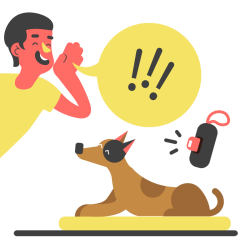How to Train the Most Destructive Dog Ever?
Post Date:
November 12, 2023
(Date Last Modified: November 13, 2025)
Dogs can display behaviors that damage property or create safety risks, and it is important to focus on humane prevention and rehabilitation rather than causing harm.
Ethical refusal and safer scope
Intentionally training a dog to be destructive or to harm people or animals is unethical and, in many jurisdictions, contrary to veterinary and animal welfare professional guidance.[1] Instead of teaching harmful behaviors, the ethical objective is to prioritize safety, the animal’s welfare, and evidence-based rehabilitation strategies that reduce risk to people and other animals.
Reasonable reader expectations include humane, incremental approaches rooted in behavior science, veterinary assessment, and, where needed, professionally supervised interventions focused on reducing destructive motivations and restoring safe behavior patterns.
Understanding destructive behavior
Destructive behaviors take many forms and targeting the underlying motivation improves the chances of a successful intervention. Common behavioral categories include chewing, digging, shredding (papers, fabric), inappropriate elimination, and destruction of resources (food containers, furniture).
- Boredom-driven chewing or shredding
- Separation-related destruction tied to anxiety
- Fear- or startle-driven destruction
- Instinctual digging or food-motivated resource destruction
Puppy chewing typically peaks between 3 and 6 months of age, when teething and exploratory mouthing are combined with high energy and novelty-seeking; interventions are different for a young puppy than for an adult dog with chronic anxiety-related chewing.[2]
Severity and context matter: a single instance of shredded paper while left with an exciting new toy is different from repeated, destructive attempts to escape confinement; the former often needs environmental management and training, while the latter may signal urgent welfare or anxiety issues that require clinical attention.
Assessing the dog: history, environment, and health
A systematic assessment begins with a veterinary exam to rule out pain, neurological disease, endocrinopathies, dental pain, or other medical causes that can increase destructive behavior risk. Standard clinic procedures often include a history, physical exam, and, when indicated, routine bloodwork or imaging to exclude medical contributors; routine blood panels commonly require 2–5 mL of blood for standard assays in dogs.[3]
Collect a behavioral history covering age at onset, breed tendencies, prior training and reinforcement histories, changes in household composition, and the timing and pattern of incidents. A home-environment audit should note confinement methods, access to items that are frequently destroyed, exercise and enrichment levels, and typical owner schedules that could provoke separation-related behaviors.
Immediate management and dog-proofing
While behavior modification proceeds, reduce opportunities for harm. Secure or remove valuable and unsafe items, use deterrents for specific items (taste deterrent sprays evaluated for safety), and establish safe containment zones. Crate confinement can be a humane management tool when used correctly; adult dogs should generally not be confined in a crate for more than 4 hours at a stretch during the day, and overnight limits are commonly suggested at up to 8 hours for healthy adults.[4]
Provide durable chew options rated for the dog’s size, avoid items with small parts that can be swallowed, and rotate safe toys so novelty reduces boredom-driven destruction. If the dog targets electrical cords, route and cover cords and consider bittering agents for exposed cables as an interim safety measure while training is performed.
Physical exercise and energy outlet planning
Matching a dog’s physical activity to its age, breed, and health profile reduces excess energy that often fuels destructive acts. Many adult dogs benefit from a cumulative 30 to 120 minutes of physical activity each day depending on breed drive and age; working or sporting breeds often require activity at the upper end of that range and structured outlets for their instincts.[5]
Create a daily plan that mixes structured walks, play sessions, and safe off-leash activity where permitted. Break activity into multiple sessions (for example, three 20–40 minute sessions) to fit owner schedules and to prevent fatigue or overstimulation; monitor the dog’s recovery and adjust intensity and duration so energy is reduced without causing injury or behavioral shutdown.
Mental enrichment and occupational tasks
Enrichment seeks to provide cognitive challenge and predictable occupation so the dog is less likely to seek destructive stimulation. Use puzzle feeders, food-dispensing toys, and scent work to create foraging opportunities; rotating puzzles every few days keeps novelty without overwhelming the dog.
Teach task-based games that leverage natural behaviors: structured retrieve chains, organized nosework searches, and short trick-training sessions can each occupy 5–15 minutes and be interspersed through the day to provide repeated, achievable tasks. Increase difficulty gradually to maintain success and confidence.
Positive reinforcement training for alternative behaviors
Focus on teaching reliable, replacement behaviors such as leave-it, drop, settle, and independent calm. Use shaping and clicker methods to mark successive approximations toward the target behavior and pair with high-value rewards to accelerate learning.
Train duration and generalization by practicing cues in multiple contexts and with increasing distractions; begin with short, successful trials and systematically extend time and distance so the dog learns to perform under real-world conditions rather than only in controlled practice sessions.
Treating separation anxiety and fear-related causes
When destruction is linked to separation anxiety or strong fear reactions, graded desensitization and counterconditioning around departures are primary behavioral tools. Begin with very short absences of seconds to a minute and only increase duration after repeated calm responses; progress is typically measured in small, steady steps rather than large time jumps.
When medication is indicated in combination with behavior therapy, common pharmacological choices are selected and dosed by a veterinarian. For example, fluoxetine is commonly used for anxiety at an initial dosing range of about 1–2 mg/kg/day; when using a 10 mg/mL oral suspension, that dose range equates to roughly 0.1–0.2 mL/kg/day.[2] Medication decisions, monitoring, and adjustments must be managed by a veterinarian with behavioral medicine experience.
Safety, aggression risk management, and emergency handling
Prioritize human and animal safety when destructive behavior escalates or is accompanied by threat signals. Conduct a bite or aggression risk assessment that documents triggers, antecedents, and injury history, and restrict interactions accordingly until a professional plan is in place.
When handling higher-risk dogs, use humane containment such as sturdy crates or gates and introduce a properly fitted basket or leather muzzle via positive association training so the dog accepts the muzzle calmly; do not use punishment or aversives that may escalate fear or aggression.
Working with professionals and creating a rehabilitation plan
Complex or high-risk cases benefit from a multidisciplinary team: an accredited veterinarian, a certified applied animal behaviorist or a trainer credentialed through reputable certification bodies, and, when needed, a veterinary behaviorist for combined medical and behavioral management. Develop measurable goals (for example, reduced destructive incidents to fewer than one per week within 12 weeks), a timeline, and objective tracking such as incident logs, video records, and standardized behavior scales.
Choose professionals who emphasize positive, evidence-based methods, who will coordinate with your veterinarian, and who can provide written plans and regular progress reviews. Expect rehabilitation to take weeks to months depending on severity, and plan follow-up adjustments based on measurable outcomes.
| Behavior | Typical age/context | Primary trigger | Initial management |
|---|---|---|---|
| Chewing | Puppies 3–6 months | Teething, boredom | Safe chews, supervision, replace items |
| Digging | All ages; outdoor context | Instinct, escape, heat | Provide digging pit, shade, exercise |
| Shredding | Any age when unsupervised | Novelty, resource access | Remove targets, enrichment rotation |
| Destructive escape attempts | Any age during confinement | Separation anxiety, fear | Behavioral plan, veterinary check, management |






